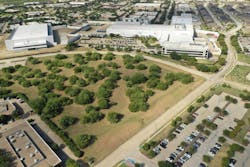Texas Senate Bill 6: A Bellwether On How States May Approach Data Center Energy Use
Texas Senate Bill 6, signed into law in late June of 2025, imposes mandates on large energy users (like data centers) to fund infrastructure upgrades, enable remote disconnection during emergencies, and register backup generators to bolster grid reliability. No less important is the goal that tariffs ensure data centers bear grid upgrade burdens, rather than passing them to residents.
SB6 will require significant disclosure from the data center industry. In its initial form, the bill applies to customers drawing 75 MW or more (a threshold that is adjustable by the PUC), including hyperscale data centers, crypto mines, and manufacturers. Probably the most significant, or at least the most noticeable requirement is setting infrastructure cost-sharing and connection standards.
Sites with large load requirements will be obligated to shoulder grid connection costs, meaning transmission, distribution, and studies, ensuring they're not subsidized by residential rates. Applications will require proof-of-site control and financial commitment to build necessary infrastructure, in addition to a minimum $100,000 fee for initial transmission screening. Additional fees may apply based on the capacity of the proposed site.
And if the screening fees aren’t enough to prevent companies from causing speculative queue congestion - also known as “phantom loads” - load developers are required to disclose similar applications elsewhere inside or outside Texas.
It’s Not Just the Power Demand
Under SB6, on-site power generation, in the form of backup power generation which must be capable of meeting 50% of the site demand, must be disclosed to utility partners and the Electric Reliability Council Of Texas (ERTCOT). ERCOT has the authority to mandate deployment of backup generators or require load curtailment during grid emergencies, and entities connecting after Dec 31, 2025 must build in remote-disconnect capabilities for use in emergency load-shedding.
This remote disconnect requirement has caused some in the industry to refer to SB6 as the “Kill Switch Bill."
SB6 empowers ERCOT to order large-load customers, like data centers, to curtail operations, switch to on-site backup generators, or completely cut power remotely if the grid is under extreme stress. The bill does require 24 hour notification, so the ERCOT won’t be flipping the switch to turn off your data center unknowingly, and there are priority exceptions available, so certain industries may end up exempted. Any curtailment will involve coordination between ERCOT, utilities, and the customer to collaborate on how to reduce power during emergencies.
Even local, behind-the-meter power generation is touched by SB6. All behind-the-meter agreements must be disclosed to ERCOT. The Council will evaluate grid impacts, and the Public Utilities Commission may approve, deny, or add conditions to such setups within 180 days. To prevent approval backlog, after those 6 months the application will default to approval. The PUC is also required to evaluate how any transmission costs are assigned to these large energy customers, with the potential to shift more of the cost burden to them and away from impacting residential energy rates.
SB6 has the goal of strengthening grid design against the skyrocketing demand from AI-driven data center growth, estimated to drive demand up to approximately 150 GW by 2030, looks to maintain a balance between the tradition pro-business Texas regulatory status while signaling that future mega-load growth must align with grid responsibility and cost accountability.
Claire Swingle, Senior Analyst, Regulatory Affairs for CPower, a company with a focus on managing and optimizing energy resources talked about the importance of these types of programs, saying:
Texas Senate Bill 6 will enhance grid reliability across ERCOT by accelerating collaboration between utilities and large energy users, specifically data centers. By tasking ERCOT with developing a program to competitively procure demand reductions in advance of periods of anticipated grid stress, SB6 affirms that proactive load management strategies, like demand response programs, are essential for creating a more resilient energy future. As ERCOT fulfills this legislative directive, it will be crucial to ensure that aggregators with long-standing expertise in cost-effectively managing these types of programs are able to participate.
Texas isn’t the first state to begin attempting to regulate energy use statewide. The impact of this legislation could shape how other states, of which there are at least a dozen in process, could shape their own programs.
What are Other States Doing?
There’s a clear shift toward targeted utility regulation for mega-load data centers. States are increasingly requiring cost alignment, with large consumers bearing infrastructure costs rather than residential cross-subsidization and implementing specialized contract/tariff terms, taking advantage of these huge contracts to uniquely tailor each contract.
These agreements are also being used to enforce environmental responsibility through reporting mandates and permitting. And for those estates still focusing on incentivization to draw data center business, coupling incentives with guardrails, balancing investment attraction with equitable distribution.
What follows is a brief overview of U.S. states that have enacted or proposed special utility regulations and requirements for data centers. The focus is on tariffs, cost-allocation mechanisms, green mandates, billing structures, and transparency rules.
California
SB 57 (2025): Introduces a special electricity tariff for large users—including data centers—with embedded zero-carbon procurement targets, aiming to integrate grid reliability with emissions goals.
AB 222 (2025): Targets consumption transparency, requiring data centers to report energy usage with a specific focus on AI-driven load.
Broader California Public Utilities actions: Proposals for efficiency mandates like airflow containment via Title 24; opening utility rate cases to analyze infrastructure cost recovery from large consumers.
Georgia
Public Service Commission rule changes (January 2025): Georgia Power can impose minimum billing, longer contract durations, and special terms for customers with loads >100 MW—chiefly data centers.
SB 34: Mandates that data centers either assume full infrastructure costs or pay equitably—not distributing these costs to residential users.
Ohio
AEP Ohio proposed in 2024: For loads >25 MW (data centers, crypto), demand minimum charges, 10-year contracts, and exit penalties before new infrastructure construction.
Focused state utility scrutiny to prevent cost-shifting onto lower-capacity consumers.
South Carolina
New energy law (May 2025): Empowers utilities like Santee Cooper to charge special higher rates to data centers and large users; institutes annual rate increases and makes appealing rate increases in these classes more difficult.
In response, Santee Cooper’s four-year experimental special rate for megawatt-level users is now operational.
Utah
Senate Bill 132: Enables direct power contracts between utilities and major users like data centers. The bill would bypass residential rate pools and add transparent, utility-protected oversight.
Minnesota
House File 3007: Implements stricter water-use permits for high-volume data centers (e.g., 100 million gallons annually), tightening environmental oversight.
Illinois
SB 94 is a little different perspective. It targets national security; data centers owned by “foreign adversaries” must undergo grid supply impact assessments.
Broader reform bills are also being considered that aim to limit data center–induced rate spikes by promoting renewables, storage, and scrutinizing energy projects.
New Jersey
Proposed bill (June 2025): Introduces a dedicated rate class for data centers exceeding 100 MW monthly demand.
Nevada
Regulators are approving data-center-specific tariffs (2025); NV Energy may offer clean energy-only rates to meet environmental goals.
Local Legislation, National Implications
The issue of regulating large-scale data center energy use has become a growing focal point for state policymakers, but there’s no one-size-fits-all approach. Each state is addressing the challenge through its own lens, often driven by local political priorities or the concerns of a single regulator or legislator. For now, these efforts remain primarily state- and region-specific.
What’s emerging, however, is a broader trend toward targeted utility oversight for large energy users like data centers. This evolving regulatory landscape introduces a new layer of complexity, particularly for operators with a multi-state footprint. Developers should expect higher upfront costs, increased reporting requirements, and closer scrutiny.
At the same time, these changes present new opportunities for operators that prioritize sustainability, transparency, and long-term grid partnership.
A Patchwork of Policies, A Unified Trend
The patchwork of evolving policies, from Texas to California to Nevada, signals more than just growing pains in the age of AI-driven demand. It marks a foundational shift in how states perceive the obligations of large power users like data centers.
No longer are incentives and tax breaks enough. Increasingly, regulators are asking data center operators not only to pay their own way, but to actively shoulder a portion of the grid’s resilience and environmental responsibilities.
While every state’s approach reflects its unique political and economic posture, the throughlines are unmistakable: cost causation must equal cost responsibility; energy transparency is becoming non-negotiable; and sustainability is no longer optional, but operationalized through rate structures, reporting, and permitting.
Targeted Utility Oversight Emerging as a New Industry Norm?
Texas SB6 may prove to be a bellwether, but it is far from an outlier. Together with proposed and enacted measures across the country, it illustrates a maturing regulatory climate where mega-load infrastructure is too impactful to be left unregulated, and too strategic to be treated casually.
For data center developers, the lesson is clear: power is no longer just a procurement conversation; it’s a political one. Navigating this landscape will demand closer partnerships with utilities, deeper engagement with policymakers, and far more robust planning on both the engineering and compliance fronts. But for those prepared to lead, this new regulatory reality also presents opportunity, an opening to differentiate on resilience, transparency, and long-term grid stewardship.
Bottom line: As AI continues to redraw the contours of compute demand, the states are beginning to redraw the rules at least (?) on power, and the data center industry must be ready to meet them on every front.
About the Author



